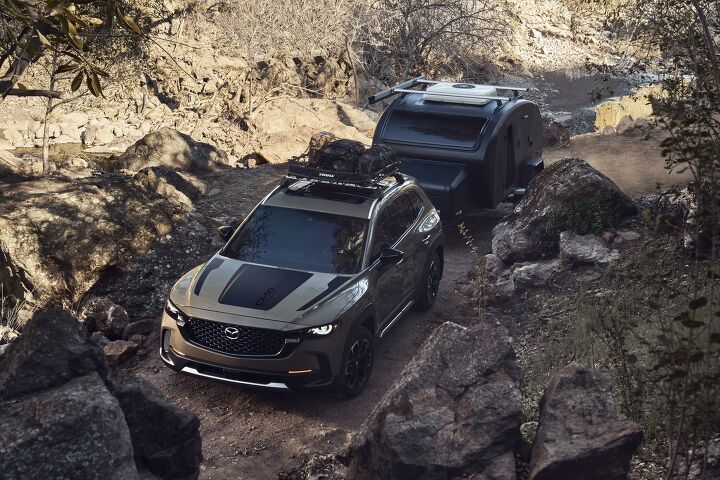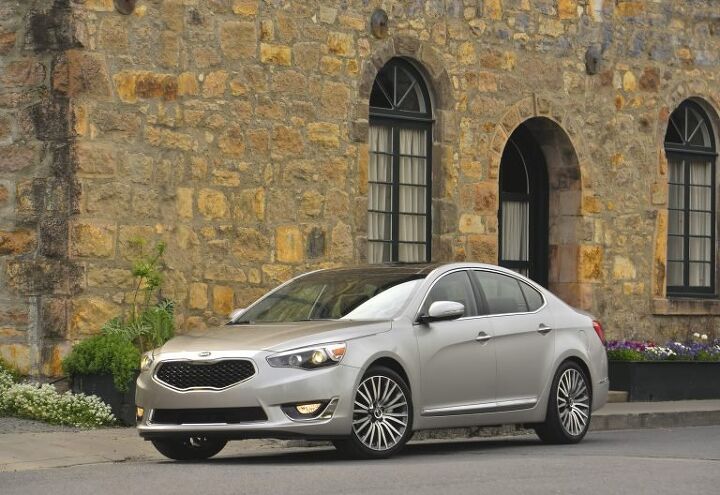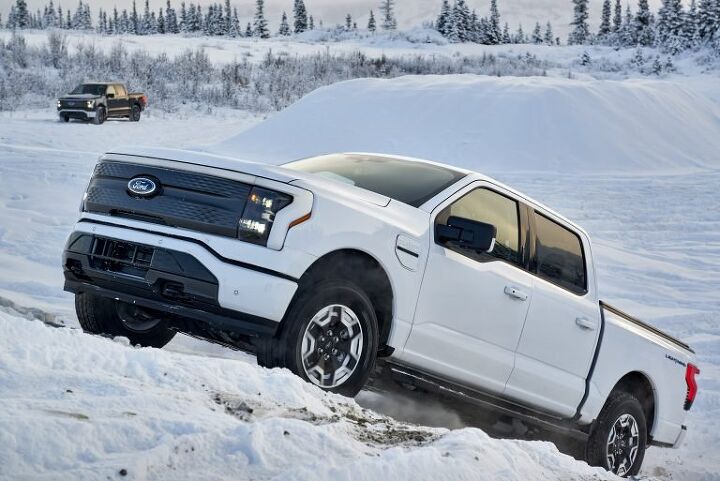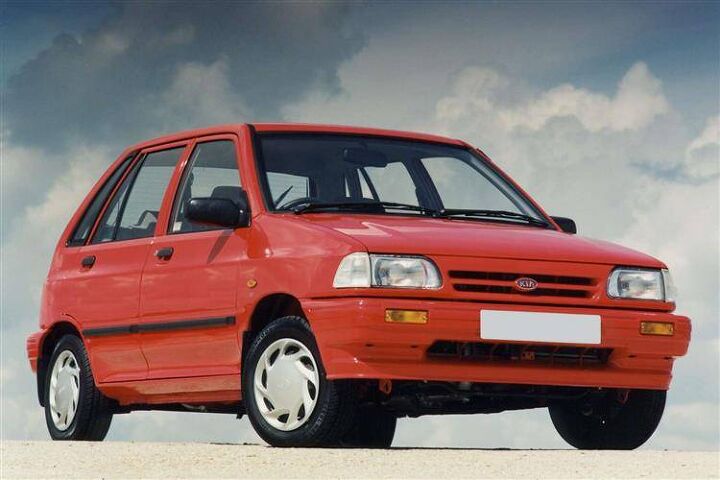#mazda
Mazda Teases Upcoming Three-Row CX-90
Mazda is moving to new platforms and engines for its latest SUVs, and the automaker just teased the upcoming CX-90 three-row.
Mazda in Wellies: CX-50 Adds Meridian Trim
Chasing the active lifestyle crowd, or perhaps cluing in that the CX-5 is an excellent machine but there’s room on the lot for a variant with a smidgen of off-road cred, Mazda introduced the CX-50 earlier this year. Think of it as a CX-5 in hiking boots and an L.L. Bean coat.
Now, the brand is taking it a step further with the CX-50 Meridian, a trim that brings all-terrain tires and a smattering of exterior accents to imply it’s ready for the trail – or at least that gravel patch at the mall.
Rare Rides Icons: The History of Kia's Larger and Full-size Sedans (Part IX)
It’s time once again for more Kia large sedan goodness. Like last time, we pick up in the early 2010s. Kia’s second full-size sedan developed under Hyundai’s controllership was the K7, or Cadenza in all markets outside South Korea. Pitched as a value-priced premium front-drive car, it competed against the likes of the Toyota Avalon and Nissan Maxima, but lacked any defined comfort or sporty characteristics. Cadenza also had a bland corporate design courtesy of the company’s new Euro-like styling mission, and former VW designer Peter Schreyer.
Shortly after the Cadenza went on sale, Kia turned its sights toward an even larger sedan: A new rear-drive one to occupy the luxury space, a class above the Cadenza. It was the largest car Kia offered in nearly two decades, the first rear-drive Kia since the (Mazda Sentia) Kia Enterprise of 2002, and the first rear-drive sedan Kia ever sold in the North American market. It’s time for K9.
2023 Mazda CX-50 Review – Playing Dress-Up
Americans have got a fever, and the only prescription is more crossovers. Virtually every automaker trying to do business in this country has some sort of lifted wagon – if not a handful. Large ones, small ones, performance ones, economy ones. No convertible crossovers anymore, thank goodness. They’re shoehorning a crossover into nearly every possible market segment.
Here, we have the 2023 Mazda CX-50, with a name very much like their popular CX-5. And it’s very close in size to said CX-5. Of the six distinct non-electric vehicles offered by Mazda, four are crossovers – but why did they bring us something so very clearly similar to something they’ve been selling well for many years without replacing it?
Oh, and don’t give Mazda any ideas about a Miata crossover, please.
Rare Rides Icons: The History of Kia's Larger and Full-size Sedans (Part VIII)
We return to Kia’s large sedan history today, at a point shortly after the launch of the K7. Kia’s full-size front-drive for the 2010s, the K7 was called Cadenza in all export markets, and was a successor to the unfortunately styled Opirus (Amanti in North America). Kia hired Peter Schreyer from his longtime employment at Volkswagen Group in order to usher in a new stylistic era at Kia.
Though it went on sale for the 2010 model year, Kia wasn’t quite ready to send the Cadenza to the North American market. With the market’s general rejection of the Amanti in mind, Kia called on Schreyer to refresh the Cadenza and lux it up before its North American launch.
Junkyard Find: 1993 Mazda MX-5 Miata
The Mazda Miata has been with us for well over three decades, becoming the best-selling two-seat sports car in history along the way. Miatas were popular as quasi-sensible commuter cars in North America well into our current century, which means that I should have been seeing at least a couple in every junkyard I’ve visited for at least the last 15 years. In fact, I still see many more discarded MGBs and Fiat 124 Sport Spiders than I do Miatas, so this reasonably intact ’93 in Crystal White paint caught my attention immediately (naturally, there was an ’81 Fiat Spider 2000 a few rows away).
Rare Rides Icons: The History of Kia's Larger and Full-size Sedans (Part VII)
We return to Kia’s midsize-or-larger sedan history today in the latter portion of the 2000s. In our last entry, we learned about the Optima, which arrived as Kia’s first midsize developed under Hyundai’s majority ownership. Sensibly the Optima was a light rework of Hyundai’s Sonata, and the two shared almost everything (including very poor crash safety ratings).
On the more executive full-size side of the lineup, Kia’s Opirus was the first large car developed under Hyundai ownership. It shared a platform with the Grandeur (XG350 to you). While the Opirus saw okay sales in most markets, it failed in North America where it was sold as the Amanti. Very few North Americans wanted a $39,600 (adjusted) Kia, no matter how many luxury styling touches it borrowed from other brands. And so the Amanti was canceled after 2009 locally (2012 elsewhere). By that time its replacement was already on sale. Meet K7.
Junkyard Find: 1989 Mazda 626 DX
Rare Rides Icons: The History of Kia's Larger and Full-size Sedans (Part VI)
We return to the story of Kia’s midsize and larger sedans today, around the point when Kia found itself under the watchful eye of Hyundai. The larger South Korean company purchased a controlling stake in its competition in 1998, which meant big changes to Kia’s product almost immediately after.
The union led to the first full-size luxury sedan Kia developed from the ground up, the Opirus (Amanti to you). It turned out the Amanti was the derivative and rather ugly sedan few in North America desired, though it fared a bit better elsewhere. But by the time the Amanti arrived, Kia was already selling a new midsize that North Americans did want. Let’s talk Optima.
Rare Rides Icons: The Ford Festiva, a Subcompact and Worldwide Kia by Mazda (Part IV)
We reached a conclusion to the first Ford Festiva (or Kia Pride, Mazda 121, SAIPA, etc.) in our last installment, which saw the little hatchback finalize its Ford duties in 1993 and its Kia responsibilities in 2000. And while it continues life today as a Wallyscar in Tunisia, our coverage here moves on to Ford’s not-so-anticipated follow-up entry to Festiva, another Festiva! It’s an Aspire to you.
Rare Rides Icons: The History of Kia's Larger and Full-size Sedans (Part V)
In our last installment of Kia’s larger sedan history, we covered the midsize Credos. The Credos was an important first for Kia, as the first midsize the company produced where it had a bit of leeway with the design. Ultimately, the Credos hid its Mazda 626 bones decently well and did a good impersonation of a late Nineties Ford Contour after a refresh.
But just as Kia settled into Mazda platforms and designing their own sedans, the goalposts were moved courtesy of the 1997 Asian financial crisis. Kia was left without much money, and few options. We pick up there.
Rare Rides Icons: The Ford Festiva, a Subcompact and Worldwide Kia by Mazda (Part III)
We return to the Ford Festiva once again today, as the subcompact Mazda-designed hatchback stormed North American shores. It did so wearing a Ford badge and a South Korean VIN, courtesy of a Kia factory. But North America wasn’t the only place it landed.
As we learned last time, the Festiva was built in several different countries and assumed many identities over an extensive history. The Festiva still has not reached the end of its life, but we’ll cover that in a separate article. We pick up today in North America, circa 1987.
Opinion: These Brands Won't Make It in the US (as EVs)
Unless you’ve been living under a rock since 2019, you’ve probably realized that just about every major carmaker has plans to go “fully electric” at some point in the rapidly approaching future. That’s going to mean big changes in the way we buy and use cars, obviously— but change is hard, and not every company is going to be willing or able to make those changes.
That equally obvious fact begs the question: who’s not gonna make it?
Rare Rides Icons: The History of Kia's Larger and Full-size Sedans (Part IV)
We return to our coverage of Kia sedans today and discuss a midsize from just prior to the flagship Enterprise we discussed last time. Kia offered the first midsize car to bear its branding in 1987 when it introduced the new Concord. Concord was essentially a broughamed, front-rear clip swap take on the GC platform Mazda 626. Mazda discontinued the GC 626 that year and immediately sold the platform and tooling to Kia. A couple of years later, the Concord spawned a lesser sibling called the Capital. Capital looked very similar to the Concord but sold to a more economically-minded customer with its much lower level of equipment and low-powered engines.
When the Capital finished up its run in 1997, it was replaced by a compact car Kia had on sale for a few years already: The Sephia. Sephia wouldn’t do for Concord-level customers though, and upon the sedan’s discontinuation in 1995 they were directed to an all-new Kia. The company was ready with its new midsize to bookend the Concord, and it went on sale the same year. Though the new car was again on a donated platform, it was the first time Kia had some leeway to design a midsize of their own. It’s time to discuss Credos.
Rare Rides Icons: The Ford Festiva, a Subcompact and Worldwide Kia by Mazda (Part II)
We return to our Rare Rides Icons coverage of the Ford Festiva today. An important world vehicle for the likes of Ford, Mazda, Kia (and eventually many others), the Festiva arrived at a time when rear-drive subcompacts were being replaced by much more efficient models that were front-drive. And the Mazda-designed Festiva was certainly more efficient and more front-drive than the Fiesta it replaced.






























Recent Comments